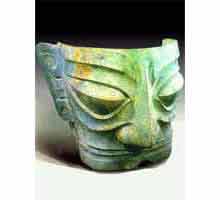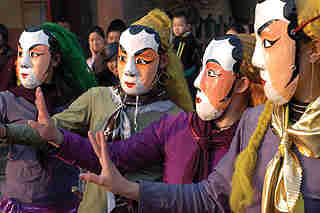 Nuo, also called the "nuo sacrifice" or "nuo ceremony," was originally a type of sacrificial and magical ritual held to expel evil spirits and pestilence. Its name is derived from one of such rituals, where people shouted "nuo, nuo" to drive away the devil.
Nuo, also called the "nuo sacrifice" or "nuo ceremony," was originally a type of sacrificial and magical ritual held to expel evil spirits and pestilence. Its name is derived from one of such rituals, where people shouted "nuo, nuo" to drive away the devil.
The nuo dance was originally performed to drive away evil spirits at sacrificial rituals during ancient times. The nuo ceremony was first recorded on bones and tortoise shells during the Shang Dynasty (16th-11th century BC), and flourished in the Zhou Dynasty (11th century-256BC). As the number of its participants increased from 100 to 1,000, the ceremony became more and more magnificent. At the time, besides the grand nuo ceremony held by the royal court, the folk nuo ceremony also appeared in the countryside.
With the development of science and technology, the dance gradually declined, and in the Central Plains in the middle and lower reaches of the Yellow River, it disappeared completely after the Song Dynasty (960-1279). Today, the dance can only be seen during the Spring Festival in remote mountainous areas, such as parts of Guizhou, Hunan, Yunnan, Sichuan, and Anhui provinces, inhabited mostly by minority ethnic groups.
The nuo dance gradually developed into a dance drama and became more of a recreation than a ritual during and after the Tang Dynasty (618-907). It is a masked drama enacted by a priest performing an exorcism, also known as "theater with a presentational aspect, a festival, and the idea of gatherings to establish ties and norms." The rituals have been incorporated into people's lives and are seen as commentaries on Chinese life.
The main characters in the dance dramas all wear vivid, lifelike, wooden masks, featuring the distinctive folk styles of the Yellow River Valley. Nowadays, the nuo dance drama still prevails in a number of Chinese provinces, including Jiangxi, Hunan, Hubei, Guizhou, Anhui, Shandong, and Hebei.
 Nuo ritual: from sacrifice to entertainment
Nuo ritual: from sacrifice to entertainment
 Wu Qianbi, a 42-year-old exorcist, performs the nuo ritual -- one type of the existing exorcism rituals -- yearly in a village of the ethnic Tujia people at the base of Fanjing Mountain in Southwest China's Guizhou Province.
Wu Qianbi, a 42-year-old exorcist, performs the nuo ritual -- one type of the existing exorcism rituals -- yearly in a village of the ethnic Tujia people at the base of Fanjing Mountain in Southwest China's Guizhou Province.
A former "living god" in the eyes of the villagers, Wu now describes his role merely as "a player who entertains."
"I still remember very well what my master told me: 'Nuo is to relieve pain for others,'" recalls Wu. "But now, for me, the most essential thing is whether or not I can bring joy to my village folk."
The nuo ritual has been practiced in China for thousands of years -- from primitive society when early men performed sacrifices and conducted ceremonial services to pay tribute to ancestors, gods, and goddesses while exorcising demons. It spread widely among people of various ethnicities in the Yangtze River Valley, the Yellow River Valley, and the secluded southwestern region.
Wu has been a "spiritual tutor", believed to possess magical powers to disperse evil demons, spirits and pestilence, for 22 consecutive years. Besides training in ritual procedures and exorcism, Wu is also adept in nuo drama.
